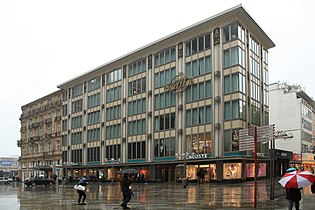
Köln Hauptbahnhof or Cologne Central Station is a railway station in Cologne, Germany. The station is an important local, national and international transport hub, with many ICE, Thalys and Intercity trains calling there, as well as regional Regional-Express, RegionalBahn and local S-Bahn trains. EuroNight and Nightjet night services also call at the station. It has frequent connections to Frankfurt by way of the Cologne–Frankfurt high-speed rail line, which starts in southern Cologne. On an average day, about 280,000 travellers frequent the station, making it the fifth busiest station in Germany.

The Cologne Stadtbahn is a light rail system in the German city of Cologne, including several surrounding cities of the Cologne Bonn Region. The term Stadtbahn denotes a system that encompasses elements of trams as well as an underground railway network (U-Bahn) and interurban rail, even including three lines that are licensed as heavy rail and used by freight trains as well as Stadtbahn vehicles. Two of these lines connect the Cologne Stadtbahn to the Bonn Stadtbahn. These lines are jointly operated by both cities' transport authorities, resulting in both systems and the lines connecting them sometimes collectively referred to as Stadtbahn Rhein-Sieg.

The Great Saint Martin Church is a Romanesque Catholic church in Cologne, Germany. Its foundations rest on remnants of a Roman chapel, built on what was then an island in the Rhine. The church was later transformed into a Benedictine monastery. The current buildings, including a soaring crossing tower that is a landmark of Cologne's Old Town, were erected between 1150-1250. The architecture of its eastern end forms a triconch or trefoil plan, consisting of three apses around the crossing, similar to that at St. Maria im Kapitol. The church was badly damaged in World War II; restoration work was completed in 1985.

The history of the Jews in Cologne dates to 321 C.E., when it was recorded in a census decreed by the Emperor Constantine I. As such, it is the oldest European Jewish community north of the Alps. The community quickly established itself in what came to be known as Cologne's Jewish quarter, building its first synagogue by 1040 C.E. The Crusades put an end to peaceful coexistence with Christians in 1096 C.E. Despite the Archbishop's protection many Jews were killed and their synagogue destroyed. The community regained its economic and religious life until about 1300 C.E., when the Christian majority again applied pressure. The community's fortunes improved and worsened a number of times into the 20th century. Before the 1930s, it consisted of 19,500 people. After the end of World War II it had been almost entirely extinguished due to Nazi destruction, expulsion and murder. Currently it numbers approximately 5,000.

Carl Moritz was a German architect and real-estate entrepreneur. Based in Cologne, he built the Cologne Opera House of 1902, and various banks, theatres and churches in Germany. Some of his buildings were destroyed during the last two years of his life in World War II.

Vincenz Statz was a Neo-Gothic German architect, mainly active in the Rhineland.

The Altenberger Dom is the former abbey church of Altenberg Abbey which was built from 1259 in Gothic style by Cistercians. Listed as a cultural heritage, it is located in Altenberg, now part of Odenthal in the Rheinisch-Bergischer Kreis, North Rhine-Westphalia, Germany. Until 1511, the church was the burial site of counts and dukes of Berg and the dukes of Jülich-Berg.
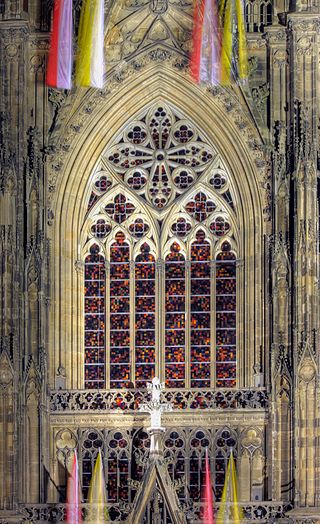
The Cologne Cathedral Window is the stained glass window in the south transept of the Cologne Cathedral designed by Cologne artist Gerhard Richter. On a surface of 106 square metres 11.263 glass squares in 72 colours of 9,6 cm × 9.6 cm were principally arranged randomly, with others selected in response to architectural context. The window was inaugurated on 25 August 2007 as part of a Eucharistic celebration; the abstract execution was both celebrated and strongly criticized.
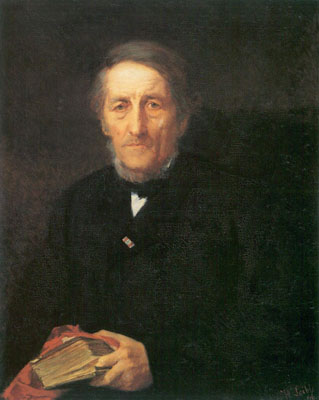
Carl (Karl) Leibl was a German musician, conductor, cathedral organist and cathedral conductor in Cologne.
Bodo Balthasar von Dewitz was a German art historian. His work focused on historical photography.
Willy Weyres was a German architect and academic teacher. He was Kölner Dombaumeister from 1944 to 1972, diocesan master builder for the Archdiocese of Cologne for more than ten years, and full professor of architectural history and monument preservation at the RWTH Aachen from 1955 until his retirement in 1972. Under his leadership, the Cologne Cathedral was restored and further developed after the Second World War.
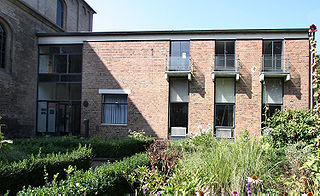
Karl Friedrich Heinrich Band was a German architect.

The Kölnische Stadtmuseum is the municipal history museum of Cologne, North Rhine-Westphalia, Germany. It is housed in the building of the historic Zeughaus with the adjacent Prussian Alte Wache Zeughaus.
Christian Schaller is a German architect working in Cologne and the Rhineland.

Arnold Wolff was a German architect. He was Cologne Cathedral Master Builder and head of the Dombauhütte of the Cologne Cathedral from 1972 to 1998. From 1986 to 1997, he was academic teacher for restoration and conservation at the Cologne University of Applied Sciences.
Maria Clementine Martin, birth name Wilhelmine Martin was the inventor of Klosterfrau Melissengeist, an alcoholic extract of herbs.
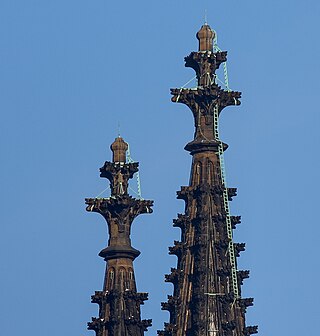
The finials of Cologne Cathedral from the tops of the two towers at a height of 149 to 157 metres. A copy of this finial in original size, but made of concrete, has stood below the steps in front of the west façade of the cathedral since 1991.
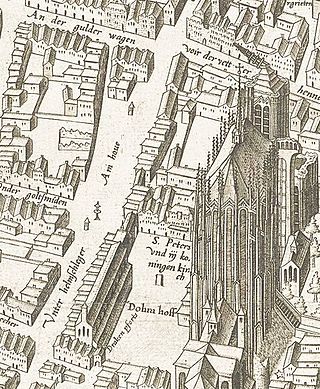
The Reifferscheider Hof or Linneper Hof was a manor of the Reifferscheid, Linnep, Sayn-Wittgenstein and Grafschaft Neuenahr families in erbvogteilichen Hacht district on the Domhof in Cologne, which was laid down in the 1740s. It was inhabited by members of the Cologne Cathedral Chapter and was a emphyteusis of the cathedral monastery. Today, the area is part of the grounds of the Romano-Germanic Museum.
The Taubenbrunnen is a fountain sculpture designed by Ewald Mataré and erected in 1953 in the Altstadt-Nord district of Cologne, situated directly in front of the west side of the Cologne Cathedral.
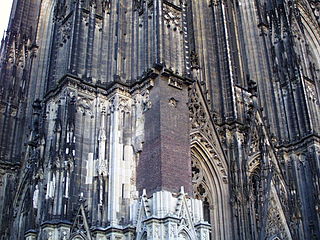
The Cologne Cathedral Seal was a section of unclad brickwork which covered destroyed masonry on an exterior pillar of Cologne Cathedral. In November 1943, during an air raid by the allies, a bomb seriously damaged a pillar on the northern tower of the cathedral, sparking fears for the structural integrity of the surrounding parts of the building. The missing sandstone was replaced with bricks by the spring of 1944, which remained visible on the north tower for over 60 years. As the last major war damage, the seal was repaired between 1995 and 2005 and faced with cut stone. Some experts had argued that the seal should be left undisguised as an anti-war memorial.










